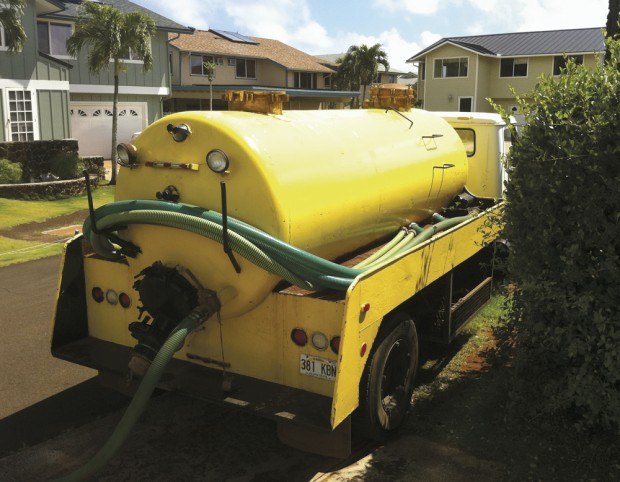POIPU — Kauai is tied with Hawaii Island for having the most high-risk areas for water quality degradation from on-site disposal systems, according to reports from the state’s Department of Health. But the island only has three properties taking advantage
POIPU — Kauai is tied with Hawaii Island for having the most high-risk areas for water quality degradation from on-site disposal systems, according to reports from the state’s Department of Health.
But the island only has three properties taking advantage of the state’s tax break program for cesspool upgrades, making a very small dent in the county’s estimated 14,000 existing cesspools.
According to the DOH study, there are three primary areas of concern on Kauai.
“In Wailua/Kapaa there is a dense clustering of on-site systems in perennial watersheds, and with a two-year travel time to the ocean, with higher risk of harm,” said DOH spokeswoman Janice Okubo. “The South Shore from Poipu to Hanapepe, and Nawiliwili also have high risks.”
The reason for such a risk is that cesspools, which are the most prevalent on-site disposal system in the higher-risk areas, don’t treat wastewater and are considered sub-standard.
Cesspools concentrate the wastewater in one location, often deep within the ground and in direct contact with groundwater, causing groundwater contamination, Okubo explained. The groundwater flows into drinking water wells, streams and the ocean, harming public health and the environment, including beaches and coral reefs.
According to a news release from DOH, the results from the water quality survey on Kauai have focused the entity’s attention on Poipu because the study identified a large number of cesspools and injection wells in the watershed, as well as a lava tube system that “may connect to Makauwahi Sinkhole/Cave next to the Waiopili Ditch.”
“Based on what was discovered with part one of the survey, we have turned our attention to the more serious issue of human fecal contamination that may exist in the Poipu-Koloa watershed,” said Keith Kawaoka, DOH deputy director of environmental health.
Initial testing with the U.S. Geological Survey confirmed that human fecal contamination was not the cause of the high bacteria levels, but the U.S. Environmental Protection Agency Region 9 working toward conducting high tech molecular testing with UC Berkeley Laboratories for more in-depth answers.
According to Carl Berg, water quality expert and head of Surfrider Kauai’s Blue Water Task Force, the study found a high concentration of nicotine in the water, which he said is a good indication of a human contaminant source.
“Cows, sheep and birds don’t know how to smoke cigarettes yet,” Berg said. “It’s a good indicator that human sewage is getting into our system.”
Berg also pointed to cesspools as the culprit, dubbing them “an ancient way of disposing human waste” that was banned in most of the U.S. 50 years ago.
He said the popular trend of switching cesspools to septic tanks isn’t going to solve the problem, though, because that will simply reduce the amount of bacteria introduced into the water system.
“Septic systems don’t take out anything really except the bacteria, they release nitrogen into the groundwater, and all these pharmaceuticals and personal care products,” Berg said. “The septic systems don’t handle that sort of stuff.”
In Berg’s view, the solution to contamination is centralized wastewater treatment plants that treat the water, and then the reclaimed water can be used for irrigation on parks and in agriculture.
“It’s no longer considered wastewater and there are ways to make sure this reclaimed water is safe,” Berg said.
The county currently has an environmental impact statement in the works to consider using the wastewater from the Waimea sewage treatment plant to irrigate the area’s baseball parks and fields.
“It’s valuable water,” Berg said. “I applaud the county’s ideas about using that wastewater for county parks. It’s going to make the parks facilities better and will cut down on how much water we buy.”
For those who are interested in taking advantage of the state’s program to upgrade from a cesspool to a septic system, there’s a possibility of securing $10,000 in tax credits.
The law, which went into effect in January, pertains to homeowners with cesspools located within 200 feet of the ocean, streams or a drinking water source. The total amount is $5 million, and homeowners must submit applications by 2020 to be in the running.
For more information, or to apply for the tax credit program, visit www. health.hawaii.gov/wastewater/home/taxcredit.


